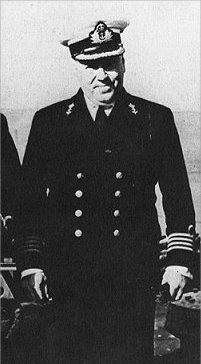![]()
Captain W. Harmsen
![]()
Captain Willem Harmsen Born Amersfoort June 14, 1893 - Died October 23, 1970 Captain Willem Harmsen is perhaps the personification of Dutch Navy fighting men of World War II. At the outbreak of war in May 1940, he was deputy head of the personnel department at the Ministry of Defence in The Hague. He offered his services to the Naval Staff that day, and performed a variety of duties during the following days at the naval headquarters in The Hague. On May 13, he left for Den Helder together with three other officers, to offer their services to Rear-Admiral Jolles. Even though Harmsen was appointed as the new Commanding Officer of the Naval Air Station De Mok, the party left for Britain in a small cutter normally used to pick up torpedoes during exercises. They arrived safely in Britain the next day. Captain Willem Harmsen is perhaps the personification of Dutch Navy fighting men of World War II. At the outbreak of war in May 1940, he was deputy head of the personnel department at the Ministry of Defence in The Hague. He offered his services to the Naval Staff that day, and performed a variety of duties during the following days at the naval headquarters in The Hague. On May 13, he left for Den Helder together with three other officers, to offer their services to Rear-Admiral Jolles. Even though Harmsen was appointed as the new Commanding Officer of the Naval Air Station De Mok, the party left for Britain in a small cutter normally used to pick up torpedoes during exercises. They arrived safely in Britain the next day.Following the reorganization in 1940, Harmsen was appointed head of the personnel department, a function which he performed until his appointment as Commanding Officer of the destroyer Hr.Ms. Campbeltown, an old American destroyer given to Britain in 1940. This ship was primarily engaged in escorting convoys on the Atlantic. During the brief period this ship was part of the R.N.N., it served with distinction, especially when salvage parties managed to save the Norwegian tanker Vinga, which, according to the Captain (Destroyers) in Liverpool, could be attributed to "very good seamanship as well as iron determination" displayed by captain and crew. In December 1941, Harmsen took over the brand new destroyer Isaac Sweers from Commander Houtsmuller, which had already distinguished herself during convoy runs in the Mediterranean and the Battle off Cape Bon. Harmsen continued to add new feats to an already excellent record. In January 1942, the ship saved almost the entire crew from the stricken British destroyer HMS Gurkha, despite the fact that the latter was almost entirely ablaze. Isaac Sweers had an untimely demise as the German U-boat U-431 put two torpedoes into her during the invasion of North Africa (Operation Torch). Harmsen survived, but was badly burned on face and chest, and spent the next months recovering from his injuries. After his recovery, he commanded the cruiser Jacob van Heemskerck, which saw service in the Indian Ocean and later in the Mediterranean.
|
||||||||||||||||||||||||||||||||||||||||||||||||
![]()
Sources
Klaassen/Van 't Haaff "Gedenkboek Adelborsten-opleiding te Willemsoord 1854-1954"
www.onderscheidingen.nl
![]()
| Back | Home |